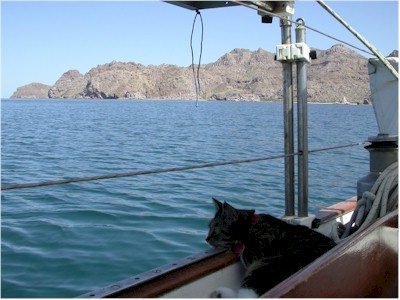
Xena enjoying Agua Verde
 |
|
Xena enjoying Agua Verde |
We are happy to report that our 2002-2003 Mexico Cruise With Cats was a success! Nobody got dehydrated, questioned by authorities, or even fell overboard. If you remember, from our September 2002 log we had left the kitties behind with the grandparents as we feared the Mexico trip would be too much for them. Actually we were glad Precious and Xena were not onboard for our heavy weather off the Oregon coast as they would probably have mutinied in Sausalito. But once they were back on board, we were always glad for their sweet purring company and entertaining antics.
I might even go out on a limb and say the kitties actually enjoyed cruising, since, like us, they feel exploring a new anchorage is vastly more interesting than sleeping all day (whether that be in your bunk or at your desk at work). Xena gets a little glimmer of excitement in her eye and runs up to the foredeck when she hears the anchor windlass cranking, wondering what the next place is going to look like...or more likely what kind of birds will visit her.
The main difference in cruising with cats between our trip down the coast and previous trips up to B.C. and Alaska was:
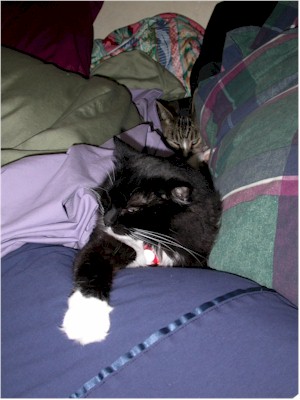 |
|
Good off-watch kitties, |
We rarely sailed at night while cruising in the north, both because the days are so long and because you only need to travel, in most cases, 10 miles or less to get to a good anchorage. But once we left Neah Bay we had many overnight legs and several of 3-4 nights.
The rule on board is that while underway, cats are not allowed out of the cockpit. We have special cat tethers located in the cockpit just for them (called "leashes" in the pet store), that hook to their harnesses to ensure that this rule is not broken. During overnight passages, we added the rule that cats are not allowed in the cockpit at all, but must stay safely below decks. Frankly, they are happier in their bunks when it is cold and dark anyway, but we have to keep a close eye on Xena as she is always trying to bend the rules.
For entering Mexico, the only regulation we were aware of was that the cats needed to have their rabies vaccination current. This was no trouble as we'd gotten these updated before even leaving home, plus the fact that no Mexican official ever asked if we had cats on board.
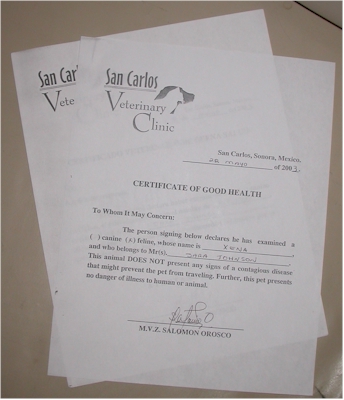 |
|
Certified healthy cats! |
In preparation to cross the border back into the United States, we got health certificates from a veterinarian in San Carlos, Salomon Orosco. This involved a short ride from the anchorage into his office off the main street (follow the signs to San Carlos Veterinary Clinic from the main road in San Carlos), a quick exam to check if they were healthy and each cat was presented with a signed certificate declaring them healthy and fit to travel back into the U.S. Xena was given her rabies booster as she was due and we got a certificate for this too ready to present at the border.
So wouldn’t you know, on the border crossing between Mexico and Arizona, the guard did not even ask if we had any animals in the car. And the cats so helpfully lay asleep on the floor so they were not noticed and we never had to show the certificates. We were glad though to have taken the precaution to avoid any potential problems at the border.
We brought along as much of the kitties regular food as we could pack on board Pelican, and we were happy to have it last until we got to Mazatlan in February.
Before arriving in Mazatlan, we were getting kind of nervous about the cats running out of kibble because the normal way cat food is sold in many small stores in Mexico is out of a giant bag of Whiskas that is laying open on the floor and looks like rats have been nibbling on it. Ewe. Coming from the land of incredibly spoiled pets, this was not going to do for our kitties.
We had heard through the cruising grapevine (i.e. the morning local VHF net) that Science Diet (one of, if not the, only premium pet food sold in Mexico) was available through a veterinarian in Mazatlan. When we arrived in Mazatlan we asked around and sure enough got directions to his office near downtown and bought several 4 lb. bags of sealed, fresh Science Diet Light for cats. Science Diet is also available at a pet groomers located in the Golden zone in Mazatlan.
In La Paz, we found Science Diet at a pet supply store located across from the CCC north of Marina de La Paz.
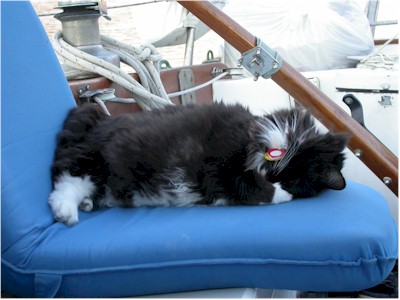 |
|
Precious taking a siesta in the shade |
This only got worse the farther south we got. Luckily after a few months in Mexico, the cats' major shedding had subsided but we always were cleaning up furballs off the floor, counters, bed, and settees.
Our only vacuum onboard was a 12-volt automotive Dust-Buster type. It did a pretty good job of picking up the cat hair, litter, and other dust bunnies, but when we go again we will take our Sears 2-gallon Craftsman shop vac which is a much more powerful sucker. We left this behind as we didn't have an inverter large enough to power it (our inverter was one of the little 300-watt plug in types), so we'll take along an inverter just large enough to power up the little shop vac and really take care of all the fur.
Having a more powerful vacuum along would also have made our lives easier with the:
You may recall our first Cruising With Cats article explained how we have been using an Astroturf doormat instead of kitty litter and simply rinsing the mat out in the sea.
|
|
|
The cat mat was banned... |
Well, this worked perfectly fine in the freezing NW, but after reaching the warmer air and waters of southern California, it was clear that this method was not going to work. It STUNK. The ammonia smell apparently multiplies exponentially with the rise in temperature and it was clear that we'd just have to endure sweeping up cat litter while down south.
After some experimentation with kitty litters, we did find that the larger pebbles, the non-clumping type, of cat litter tracked a lot less than the clumping types. So original Tidy Cats it was.
The good news is that we found this type of cat litter all throughout Mexico so we never had a problem with running short.
An Update on the Update: Since returning to the NW and land of Pet Superstores like Petco, we have discovered a type of litter that works GREAT onboard. It is the litter made of recycled paper pellets. It’s green and looks like rabbit food. Because the pellets are so large, the litter is rarely tracked more than a foot away from the litter box (unlike the clay litter, the pebbles manage to find their way all over the boat, in every crack it seems). We put a few inches of the paper pellet litter in the litter box and just throw the whole mess out every few days, or when it appears saturated. It’s very affordable too; a 30 lb. bag can be bought for around $10 and lasts at least a month.
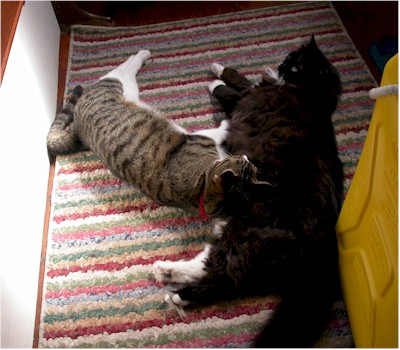 |
|
Lazing around when it's hot, just like us |
We didn’t have too many issues with the cats getting overheated or dehydrated. We kept their water bowl full at all times and they helped themselves to it often. They would do pretty much what we did during the really hot days – lay around in the shade, and then start running around at night when it cooled off.
Next time though, since Precious is a long-haired black cat, if our old girl is still with us we will bring a good set of hair clippers and give her a lion cut to help her keep cool (shave all her body except her tail and head); she really seemed to be miserably hot on a number of days. Luckily Xena is a short-haired cat and didn’t appear to suffer much.
Actually the only bad heat-related occasion with the cats was on the drive back home; the cats had been comfortably cool in our air-conditioned car. We stopped near Tucson for some food and to stretch our legs and decided to put the kitties on their leashes and let them stretch their legs too. BIG MISTAKE! They reacted very badly by suddenly going from the 70 degree car to the 100 degree outdoors and immediately lay panting and limp on the ground. We quickly put them back in the car and turned up the air conditioning full blast to let them cool back down. They recovered quickly, but it was a frightening reminder that cats do not have very efficient temperature regulatory systems – never move a cat rapidly from one air temperature to another of significant difference as it may shock them.
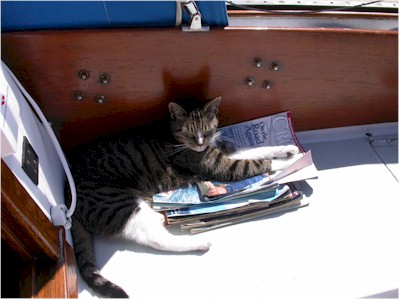 |
|
Xena catches up on her magazines |
Finally, we are often asked what we did with the cats during any inland travels we had. On this trip, we only took two short inland trips, to Guanajuato and up to Tucson to buy a car; for both trips we were gone only two nights. On our trip to Guanajuato, just like at home, we left the cats extra food and water and a clean litter box and they just spent the two nights home alone. It was during the winter so the temperature inside Pelican was not in danger if getting too hot.
On our trip to Tucson, we left Pelican and the kitties anchored out in San Carlos and had our friends anchored nearby keeping an eye on Pelican and her two feline crew. The kitties were spoiled this trip as our friends came over every day and checked on them and gave them some attention – which our pet-less friends said they enjoyed very much!
I’m sure if we’d wanted to go on a longer inland trip, it would be fairly easy to find a fellow cruiser to check on the cats every day since this is the wonderful thing about sailors and sailing – we take care of each other and our furry friends.
Back to the Projects & Ideas Index